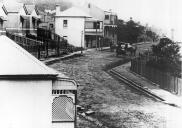|
‘Graythwaite’ and the Euroka EstateThe story of ‘Graythwaite’ and its surrounds is intertwined with many aspects of North Sydney’s history from the subdivision of the early large estates, the impact of the Great War and on to resident action, and the long-established pattern of the acquisition of grand homes by private schools.The large house that survives today in the grounds of Shore School evolved from a smaller stone villa called ‘Euroka’, itself built upon land bought from the Crown by Thomas Walker in 1832 - the year after the granting of free land ended. Walker promptly sold off most of his 39 acres and kept thirteen which would become known as the Euroka Estate. The name ‘Euroka’ is probably of Aboriginal origin. It had widespread use in the colony in the mid-1800s, referring variously to a place near Kempsey, a village near Bathurst, the name of a steamship, and that of a race horse. The name Euroka was attached to the villa, and therefore the surrounding property, by the ship’s captain Edwin Mawney Sayers when he acquired both in 1853. Sayers added a large double storey wing to the single storey villa in 1859. A sale notice in 1867 referred to it as having ‘a magnificent drawing-room... a spacious dining-room, breakfast room, library, 5 bedrooms, bath and dressing rooms, cellars...offices; kitchen, servant’s room’ with numerous outhouses. With its next owner, the banker Thomas Dibbs, ‘Euroka’ got bigger again. After his purchase in 1873, Dibbs demolished the single storey villa and added a completely new Italianiate-style mansion to the two-storey addition. He renamed the house ‘Graythwaite’ after ‘Graythwaite Hall’, the ancestral home of his wife in Cumbria, England. The name ‘Euroka’ remained with the estate which Dibbs proceeded to subdivide into large lots along the Union Street frontage and tiny blocks along Bank, Euroka and Clifton Streets. These would come to accommodate small timber and brick houses – workers’ dwellings that stood in contrast to the grand home on the hill. This was the heart of Henry Lawson’s North Sydney. He described one of the streets and referred obliquely to the 'Graythwaite' 'grounds' in the 1915 poem ‘Kiddies Land’: ‘The street is old and built of stone - / And other things beside; / And though in length its very short, / The roadway’s fairly wide. / Our Street is blind, and at the top / Are “Grounds” where gnarled trees stand, / Like gnomes against the evening sky - / Down here in Kiddies Land’. In 1915 Dibbs made his home ‘Graythwaite’ available for use as a hospital for injured soldiers, as several wealthy people did during the Great War. However Dibbs actually gave, rather than lent, his property to the State. The deed of gift stipulated that ‘Graythwaite’ be used as ‘a Convalescent Home in perpetuity for distressed subjects of the British Empire regardless of Sect or Creed’. ‘Graythwaite’ became a nursing home but by the end of the century it was increasingly difficult to fulfill this function in a structure built a century earlier for a different purpose. In 2009 the Supreme Court of New South Wales overturned the original deed of gift and ‘Graythwaite’ was put on the market. Despite considerable opposition from North Sydney Council and members of the local community, who argued that the property should remain publicly-owned, the neighbouring Church of England Grammar ‘Shore’ School bought the house and its surrounding garden. ‘Graythwaite’ was restored and now functions as a school adminstration building and museum. Audio: Listen to Jean Blundell and Joan Smith talk about 'class' consciousness in North Sydney in the early 20th century. Merle Coppell Oral History Collection, OH100 |
|






